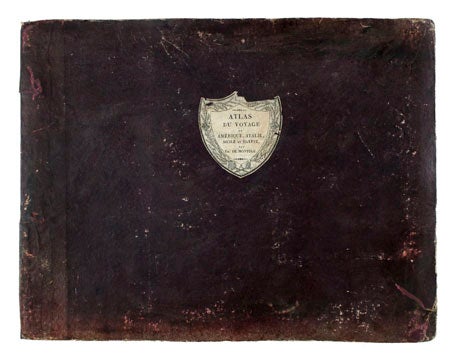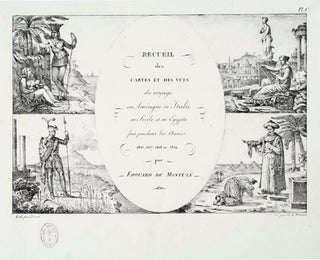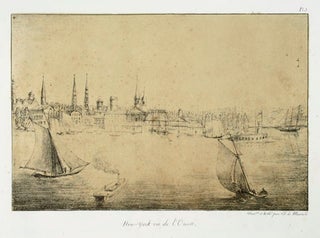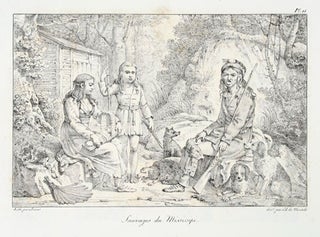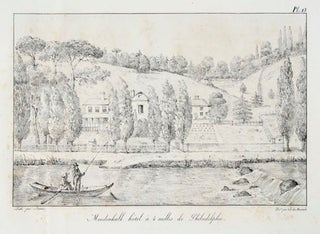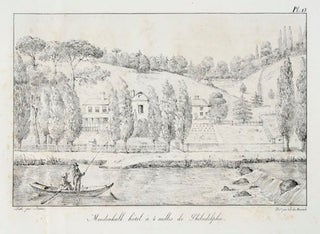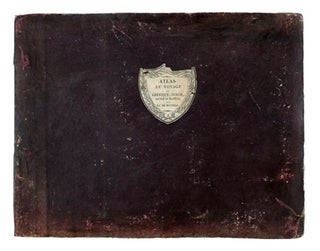Recueil des Cartes et des Vues du Voyage en Amerique en Italie et en Egypte...
MONTULE, Édouard de. Recueil des Cartes et des Vues du Voyage en Amerique en Italie et en Égypte fait pendant les Annees 1816, 1817, 1818 et 1819. Atlas vol.: 59 numbered lithographed plates, comprising: lithographed title within oval cartouche framed by 4 allegorical vignettes depicting America, Italy, Sicily and Egypt, by Brocas after Montulé; 2 folding maps, of eastern North America and of the Nile basin, both after Montulé, the first drawn on stone by Moulin; and 56 plates, 14 by Brocas and the remainder by Montulé, after Montulé's drawings, and printed at the lithographic press of the Comte de Lasteyrie, except pl. 9, printed by Marlet. Oblong folio. Contemporary (original?) boards, with paper label. Paris: Delaunay, 1821. WITH
__________. Voyage to North America and the West Indies in 1817. 6 plates. 8vo., modern wrappers. London: Sir Richard Phillips, 1821. WITH
__________. Travels in Egypt during 1818 and 1819. 12 plates. 8vo., modern wrappers. London: Sir Richard Phillips, 1821.
A splendid copy of this rare early lithographic work documenting Montulé's early exploratory voyage to the Mississippi region just after the Louisiana Purchase. The set comprises the important original French atlas of lithographs and the first editions of the English text.
Édouard de Montulé appears to have first visited North America at the time of the Revolution. In his account, first printed in French in 1821, he relates, in letter form, a voyage from September 1816 to October 1817, from New York to the West Indies, with stops in St. Thomas, Jamaica, and Santo Domingo, and returning north via New Orleans and the Mississippi to the Ohio river regions and the Hudson valley. "The account is significant because it relates Montulé's experiences during his journey up the Mississippi on board the Vesuvius, which is said to have been the third steamboat to ply the waters of the Mississippi. The boat and its navigation are described in detail. Another distinguishing feature of the narrative is the information it contains about Frenchmen in the United States, especially Napoleonic refugees" (Clark, Travels in the New South, II, 47). The remainder of his account (published separately in the English translation) describes his subsequent travels in Sicily and Egypt.
In the preface to the French text Montulé states that he "would have never published these letters without the help of lithography," a new graphic technique whose ease of execution convinced him to share with the public some of the sketches he had made in his travels. He apologizes for not having made use of eminent artists, as the cost would have rendered the work too expensive. In fact his lithographs are expressively executed, full of carefully observed detail, and important for their early date: a number of Montulé's plates are in fact lithographic "firsts," notably plate 3, the fine view of New York seen from the west, which appears to be the earliest lithographed view of New York City. It is the earliest view of New York listed by John Reps, whose union catalogue of American city views purports to list all separately published lithographic city views of America. (Reps lists this view and Montulé's small lithograph of a village near Natchez [Mississippi], indicating that these were occasionally sold separately.) Other "firsts" are the depiction of the skeleton of a mammoth in the Philadelphia Museum, several views of Philadelphia itself, a group of unidentified Native Americans of the Mississippi region, an "encounter with a rattlesnake on the bank of the Ohio River," and two views of Niagara Falls. Several lithographs show regions of the West Indies and their inhabitants, and one shows a Native American funeral mound. The English translations, published in London the same year, are illustrated with reduced engraved reproductions of the lithographs.
Montulé's lithographs have been somewhat neglected in the standard repertories of early American prints and bibliographies of American travel books, surprisingly, since his prints predate by several years more celebrated collections of French lithographic views of America (e.g., Milbert's Itinéraire pittoresque du Fleuve Hudson, published in 1828-1829, and other American-produced examples). The lithographs are equally noteworthy for their origin: they were produced at the lithographic press of Count Charles-Philibert Lasteyrie du Saillant, who had traveled to Munich in 1812 to learn the art of lithography from Senefelder, and whose lithographic press, established in Paris in 1816, vied with Godefroy Engelmann's for the title of first Parisian lithographic printing establishment.
Brunet III, 1874 (59 plates). Sabin 50229 (51 plates). Howes M750 ("the plates are highly interesting"). John W. Reps Views and Viewmakers of Urban America, Univ. of Missouri, 1984, 1973 and 2624 (Natchez and NYC views). Stokes, V:1588, 1595-6.
Item nr. 119879
Price:
$8,500.00

